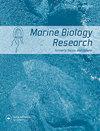从贻贝床上清除的海螺和普通海星的再定居行为
IF 1.2
4区 生物学
Q4 ECOLOGY
引用次数: 1
摘要
摘要本研究旨在研究拉帕海螺(Rapana venosa)和普通海星(Asterias rubens)在其自然栖息地贻贝床上的再定居行为。监测研究是在2020年10月19日至2021年8月9日期间在马尔马拉海(土耳其)一个被完整贻贝床覆盖的岛屿上季节性进行的。对实验研究岛(ESI)上的居民rapa whelk和普通海星进行标记,并将其移至距离ESI 10 m的地方。每个季节在局部消灭后,通过水下调查监测标记入侵者的重新定居潜力,为期14天。监测期末,rapa海螺返回ESI的比例高于普通海星。海螺不停地向贻贝床移动,最迟在6小时到达ESI。普通海星到达贻贝床的时间要比海螺晚得多(15小时)。普通海星在第7天结束时开始离开ESI,而rapa海螺在第14天开始对ESI上瘾。再次入侵行为的季节差异显著,两种入侵者在冬季到达ESI的时间都要晚得多。在监测期间,贻贝最丰富的斑块的入侵密度最高,表明持续不间断的摄食。再次入侵的持续时间和每天的进食活动支持了这些入侵者的传播,并可能被认为是对海洋资源的威胁。本文章由计算机程序翻译,如有差异,请以英文原文为准。
Recolonization behavior of rapa whelk (Rapana venosa) and common starfish (Asterias rubens) eradicated from mussel bed
ABSTRACT This study aimed to investigate the recolonization behaviour of the rapa whelk (Rapana venosa) and the common starfish (Asterias rubens) on the mussel beds in their natural habitat. The monitoring studies were carried out seasonally on an island covered by a complete mussel bed in the Sea of Marmara (Turkey) between 19 October 2020 and 9 August 2021. Inhabitant rapa whelk and common starfish on the experimental study island (ESI) were tagged, then moved 10 m away from ESI. The recolonization potential of tagged invaders was monitored for 14 days with underwater surveys after their local eradication each season. The percentage of returned rapa whelk to the ESI was higher than common starfish end of the monitoring period. Rapa whelk moved non-stop towards the mussel bed, reaching the ESI at the latest 6th hour. Common starfish reached the mussel bed much later (at the 15th hour) than rapa whelk. The common starfish began to leave the ESI at the end of the 7th day, while the rapa whelk addicted to the ESI for 14 days. Re-invasion behaviour varied significantly seasonally, and both invaders reached the ESI much later in winter. During the monitoring periods, the highest invader densities were seen in the patches with the most abundant mussels, indicating continued uninterrupted feeding. The re-invasion duration and daily feeding activities support the spread of these invaders and could be considered a threat to marine resources.
求助全文
通过发布文献求助,成功后即可免费获取论文全文。
去求助
来源期刊

Marine Biology Research
生物-海洋与淡水生物学
CiteScore
2.10
自引率
0.00%
发文量
55
审稿时长
6-12 weeks
期刊介绍:
Marine Biology Research (MBRJ) provides a worldwide forum for key information, ideas and discussion on all areas of marine biology and biological oceanography. Founded in 2005 as a merger of two Scandinavian journals, Sarsia and Ophelia, MBRJ is based today at the Institute of Marine Research, Bergen, Norway. The Journal’s scope encompasses basic and applied research from all oceans and marine habitats and on all marine organisms, the main criterium for acceptance being quality.
 求助内容:
求助内容: 应助结果提醒方式:
应助结果提醒方式:


